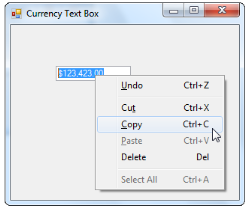- Clipboard Support
- Overflow Indicator
- Globalization
Contact Support
Advanced Features in Windows Forms Currency Textbox (CurrencyTextbox)
4 Feb 20253 minutes to read
Clipboard Support
The CurrencyTextBox control also provides support for clipboard operations that are compatible with currency data. The ClipMode property specifies if formatting characters are to be copied to the clipboard.
this.currencyTextBox1.ClipMode = Syncfusion.Windows.Forms.Tools.CurrencyClipModes.ExcludeFormatting;Me.currencyTextBox1.ClipMode = Syncfusion.Windows.Forms.Tools.CurrencyClipModes.ExcludeFormatting
Overflow Indicator
You can display an indicator in the textbox, when the currency value is displayed, beyond its boundaries. We can also display tooltip for the overflow indicator. The tooltip text is specified in OverflowIndicatorToolTipText. Set ShowOverflowIndicator property to true to enable this feature. Set ShowOverflowIndicatorToolTip property to true to display the tooltip text.
this.currencyTextBox1.OverflowIndicatorToolTipText = "Overflow";
this.currencyTextBox1.ShowOverflowIndicator = true;
this.currencyTextBox1.ShowOverflowIndicatorToolTip = true;Me.currencyTextBox1.OverflowIndicatorToolTipText = "Overflow"
Me.currencyTextBox1.ShowOverflowIndicator = True
Me.currencyTextBox1.ShowOverflowIndicatorToolTip = True
Globalization
The CurrencyTextBox class is globalization aware and uses System.Globalization.CultureInfo for locale-specific information. You can set the control’s culture to any installed culture through its culture property.

this.currencyTextBox1.Culture = new System.Globalization.CultureInfo("ar-SA");
this.currencyTextBox1.CurrentCultureRefresh = true;
this.currencyTextBox1.SpecialCultureValue = Syncfusion.Windows.Forms.Tools.SpecialCultureValues.None;Me.currencyTextBox1.Culture = New System.Globalization.CultureInfo("ar-SA")
Me.currencyTextBox1.CurrentCultureRefresh = True
Me.currencyTextBox1.SpecialCultureValue = Syncfusion.Windows.Forms.Tools.SpecialCultureValues.NoneUser Override for Culture
|
CurrencyTextBox Properties |
Description |
| UseUserOverride | Specifies if the NumberFormatInfo used for formatting will use the User overrides for the culture. |
this.currencyTextBox1.UseUserOverride = false;
this.currencyTextBox1.Culture = new CultureInfo(CultureInfo.CurrentUICulture.LCID,this.currencyTextBox1.UseUserOverride);Me.currencyTextBox1.UseUserOverride = False
Me.currencyTextBox1.Culture = New CultureInfo(CultureInfo.CurrentUICulture.LCID,Me.currencyTextBox1.UseUserOverride)Culture name
The culture name can be displayed in the different format according to the specified culture value. Refer the following table in detail.
|
CurrencyTextBox.Culture Properties |
Description |
| DisplayName | Gets the culture name in the format "<language full>(<country/region full>)" in the language of the localized version of the .NET Framework. |
| EnglishName | Gets the culture name in the format "<language full>(<country/region full>)" in English. |
| NativeName | Gets the culture name in the format "<language full>(<country/region full>)" in the language that the culture is set to display. |
| ThreeLetterWindowsLanguageName | Gets the three letter code for the language as specified in the windows API. |
The following figure illustrates this when the culture is ‘en-US’.
this.label11.Text = this.currencyTextBox1.Culture.DisplayName;
this.label12.Text = this.currencyTextBox1.Culture.EnglishName;
this.label13.Text = this.currencyTextBox1.Culture.NativeName;
this.label14.Text = this.currencyTextBox1.Culture.ThreeLetterWindowsLanguageName;Me.label11.Text = Me.currencyTextBox1.Culture.DisplayName
Me.label12.Text = Me.currencyTextBox1.Culture.EnglishName
Me.label13.Text = Me.currencyTextBox1.Culture.NativeName
Me.label14.Text = Me.currencyTextBox1.Culture.ThreeLetterWindowsLanguageName